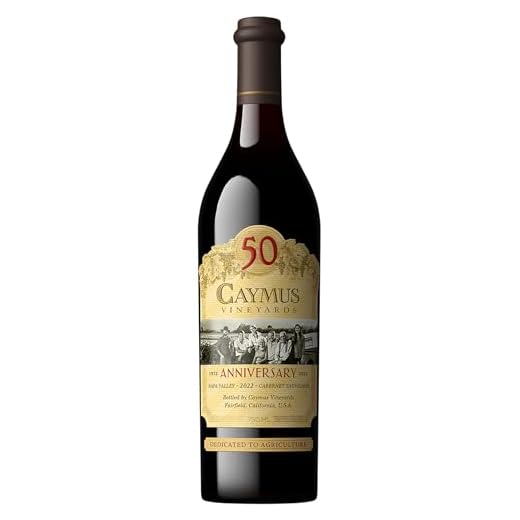



For a delightful experience, I recommend exploring a bottle of Barolo from Piedmont. This Nebbiolo-based gem offers complex aromas of tar, rose, and cherry, making it a stunning companion for rich dishes like osso buco.
If you’re seeking something more approachable, consider a bottle of Pinot Noir from Oregon’s Willamette Valley. Its bright acidity and layers of red fruit flavors present an elegant option that complements lighter fare such as salmon or roasted vegetables.
Another excellent selection comes from the Southern Rhône region; a Châteauneuf-du-Pape delivers a robust blend of Grenache, Syrah, and Mourvèdre. With its hearty structure and notes of dark fruit and herbs, this wine is perfect for grilled meats and hearty stews.
For an affordable yet impressive choice, a Malbec from Argentina is ideal. Its bold flavors of plum and blackberry paired with subtle spice make it a fantastic match for barbecued dishes and even dark chocolate desserts.
Exploring these selections not only introduces you to diverse flavor profiles but also enhances your culinary experiences. Each bottle tells its own story and connects you to the regions and traditions that shaped it.
Top Red Wine Varietals for Beginners
Merlot stands out as an excellent choice for newcomers. Its smooth texture, medium body, and soft tannins make it approachable. Flavors of cherry, plum, and chocolate appeal to many palates, making it versatile for pairing with various dishes.
Cabernet Sauvignon
This varietal is a staple for enthusiasts. Rich, full-bodied, and often exhibiting notes of blackcurrant, cedar, and spice, it pairs beautifully with grilled meats and hearty stews. Look for bottles from regions like Napa Valley or Chile for great quality at reasonable prices.
Pinot Noir
Light to medium-bodied, Pinot Noir offers complexity without overwhelming tannins. Its flavors range from red fruits like raspberry and cherry to earthy undertones. Burgundy is classic, but explore options from Oregon and California for value and quality.
Syrah, also known as Shiraz, brings boldness with dark fruit flavors and peppery spice. It complements barbecued dishes and rich sauces. Seek out Australian Shiraz for a fruit-forward experience.
Tempranillo provides a unique Spanish twist. Its flavors of cherry, leather, and vanilla make it suitable for diverse cuisines, particularly tapas. Look for bottles from Rioja for a classic interpretation.
Each varietal offers distinct characteristics, making exploration enjoyable. Start with these selections, and you’ll build a solid foundation for appreciating finer offerings in the future.
How to Choose Wine for Food Pairing
Focus on the weight and intensity of both the dish and the beverage. Heavy meals often require full-bodied selections, while lighter fare pairs better with delicate options.
Acidity plays a critical role. Dishes with high acidity, like tomato-based sauces, harmonize beautifully with wines that possess similar acidity levels. For creamy dishes, opt for fruit-forward varieties that offer a balance.
Tannins can enhance the experience with protein-rich foods. Pairing grilled meats with tannic selections can elevate flavors. Conversely, for lighter proteins, consider softer tannin options that won’t overpower the dish.
Here’s a simple guide for pairing:
| Food Type | Recommended Varietals |
|---|---|
| Grilled Steak | Cabernet Sauvignon, Malbec |
| Roast Chicken | Pinot Noir, Grenache |
| Pasta with Marinara | Sangiovese, Barbera |
| Spicy Dishes | Zinfandel, Syrah |
| Cheese | Merlot, Tempranillo |
Lastly, personal preference matters. Trust your palate and experiment with combinations. Discovering what works for you is part of the enjoyment in this culinary adventure.
Best Regions for Quality Red Varietals
For exceptional selections, I recommend exploring Napa Valley in California, renowned for its bold Cabernet Sauvignon and elegant Merlot. The diverse microclimates here contribute to the complexity and rich flavors found in each bottle.
Another noteworthy area is Bordeaux in France, where blends of Cabernet Sauvignon, Merlot, and Cabernet Franc showcase the region’s terroir. The Left Bank and Right Bank offer distinct profiles, catering to both robust and softer palates.
Tuscany in Italy shines with its Sangiovese grapes, producing Chianti and Brunello di Montalcino. The balance of acidity and tannins creates a perfect match for Italian cuisine.
Consider exploring the Barossa Valley in Australia, famous for its Shiraz. The warm climate yields ripe fruits and spicy notes, making it a favorite among enthusiasts.
For something unique, turn to the Douro Valley in Portugal. Known for its Port wines, this region also produces dry reds that are rich and full-bodied, often featuring indigenous grape varieties like Touriga Nacional.
Lastly, don’t overlook the Willamette Valley in Oregon, celebrated for its Pinot Noir. The cool climate enhances the grape’s delicate characteristics, resulting in wines that are both nuanced and expressive.
Understanding Ratings and Reviews for Red Varietals
Pay attention to expert reviews and ratings from reputable sources. Websites like Wine Spectator, Robert Parker’s Wine Advocate, and James Suckling provide detailed assessments. Look for wines scoring above 90 points for exceptional quality. These ratings often reflect a wine’s complexity, balance, and aging potential.
Decoding Tasting Notes
Tasting notes can be subjective but serve as valuable guides. Familiarize yourself with common descriptors such as fruit, acidity, tannins, and finish. For instance, a wine described as having “ripe blackberries, velvety tannins, and a long, spicy finish” indicates a well-structured bottle that pairs wonderfully with grilled meats.
Consumer Feedback
Don’t overlook user-generated reviews on platforms like Vivino or CellarTracker. While these opinions can vary, they offer insights into how a wine performs in everyday settings. Look for patterns in feedback, especially regarding aging potential and pairing suggestions.
Lastly, trust your palate. Experimenting with various selections and noting your preferences can help you refine your choices over time. Remember, wine appreciation evolves; what resonates today might shift tomorrow. Enjoy the exploration!
Affordable Options That Don’t Compromise on Quality
Look for Malbec from Argentina. These offerings often deliver rich fruit flavors and velvety textures without breaking the bank. Brands like Alamos and Catena Zapata consistently provide excellent quality at reasonable prices.
Consider Tempranillo from Spain, particularly from regions like Rioja. Marques de Riscal and Campo Viejo provide exceptional value. Their wines showcase cherry and plum notes with a hint of oak, making them ideal companions for various dishes.
Another great choice is Cabernet Sauvignon from California. You can find impressive selections from producers like Bogle and Josh Cellars. These bottles often reveal bold flavors of blackberry and cassis, accompanied by subtle tannins.
Don’t overlook Pinot Noir from regions such as Oregon or California. Brands like Mark West and Meiomi offer approachable options with bright acidity, making them versatile for food pairings. Their light body and red fruit characteristics appeal to many palates.
For a delightful alternative, explore Garnacha from Spain. Look for bottles from producers like Borsao or Las Rocas. These wines deliver juicy berry flavors and spice notes at a fraction of the cost of more famous varietals.
Lastly, check out Syrah from Australia. Producers like Penfolds and Wolf Blass provide rich, full-bodied examples that often feature black pepper and dark fruit flavors. These selections are typically priced reasonably without sacrificing quality.
Tips for Storing and Serving Red Wine Properly
Maintain optimal quality by storing bottles horizontally. This keeps the cork moist, preventing it from drying out and allowing air into the bottle.
Temperature control is paramount. Ideal storage conditions range from 55°F to 65°F (13°C to 18°C). Avoid fluctuations, as they can spoil the flavor profile.
Light exposure negatively impacts wine. Store in a dark place or use UV-filtering bottles to protect from harmful light.
Humidity should be around 70%. This helps preserve cork integrity. Use a hygrometer to monitor levels.
When serving, decant younger varietals for about 30 minutes to aerate and soften tannins. Older wines may only need gentle pouring to avoid sediment disturbance.
Serve at proper temperatures: lighter styles like Pinot Noir around 55°F (13°C) and fuller-bodied options like Cabernet Sauvignon at 60°F (16°C).
- Use appropriate glassware to enhance aroma and flavor.
- Pour a modest amount, about one-third of the glass, to allow for oxygen interaction.
- Consider food pairings for an enhanced experience; for example, how to cook leg of lamb steaks in the oven pairs beautifully with Merlot.
Lastly, always re-cork unfinished bottles and store them upright in the fridge for a short period. This preserves flavors for your next indulgence.









